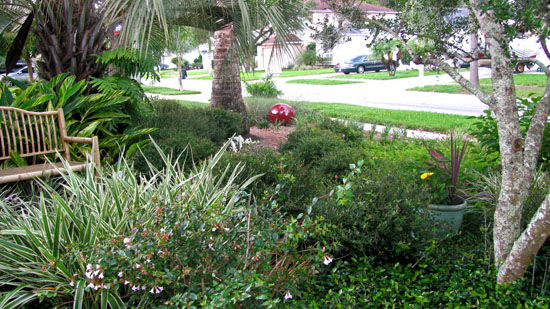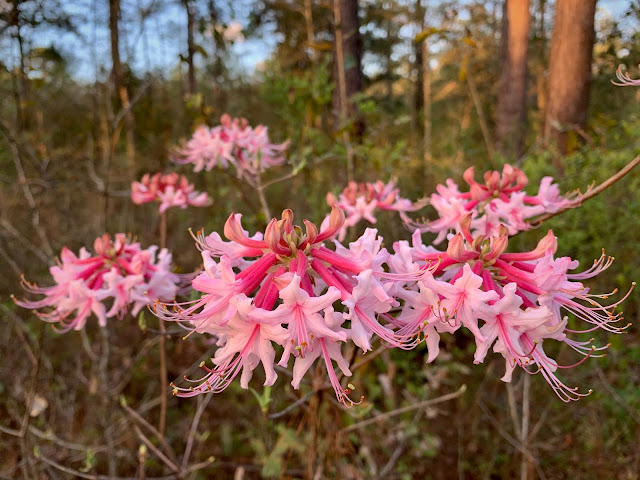Grass-free and Deed-Restricted: An Impossible Dream?
 |
| An impossible dream in an HOA-controlled community? Pam Brown's front yard In Pinellas County. |
I hear it all the time. Folks who live in deed-restricted communities tell me they can’t remove even a blade of grass from their front yard for fear of recrimination from their evil HOAs.
But is this really the case? Probably not. I think acceptance of “non-traditional” landscapes depends largely on how you deliver your pitch, and the effort you put into making your case for an alternative to the typical turfgrass-dominated yard with a couple of scraggly palm trees and a neatly manicured hedge of shrubs along the front of the house.
State laws enacted in recent years make it clear that HOAs cannot prevent homeowners from implementing Florida-Friendly landscapes. Many homeowner associations may not be aware of this (especially if no one has bothered to inform them about it), and still more are unclear about what a “Florida Yard” looks like. They fear, understandably, a profusion of neglected yards filled with weeds, ugly bare patches or gravel. I don’t blame them for that. Neglected, unmaintained yards are not Florida Yards. They are just neglected, unmaintained yards.
I believe concern for aesthetics is what drives much of the resistance to alternative landscapes. After all, this is why there are deed restrictions in the first place – to protect the overall appearance and property values of the neighborhood.
So, how does a homeowner who lives in a deed-restricted community but wants to transition to a more water-saving, sustainable landscape – even one that features, GASP, native plants -- open a positive and civil dialogue with their HOA Board? Here are a few tips:
1. Read your HOA documents! Many residents automatically assume their deed restrictions say they must have only grass, and St. Augustine grass at that. That is rarely the case. Yours may specify that the front yard must be “grassed” or “vegetated” but I don’t know of any that mandate ALL grass, or even that a majority of the landscape must be turfgrass. Knowing the specific rules in your community is the first step; this is your responsibility.
2. Understand your limitations and work within them. If you choose to live in a deed-restricted community, then you have agreed to abide by the restrictions required of residents. This doesn’t mean you can’t create a beautiful, Florida-appropriate landscape, but it may well mean you can’t put a vegetable garden in your front yard, or have a landscape composed primarily of mulch, or stick a rain barrel by your front door. Although state law allows Florida-friendly landscapes even in HOAs, the HOA itself still has the right to impose aesthetic standards that are consistent with the community norms.
3. Follow the process. Send a formal letter to your HOA Board asking to present your landscaping request at an upcoming meeting. Don’t know what to say? Find a sample letter, and other great resources, in the “Homeowners Toolkit” on the Be Floridian website at www.BeFloridian.org
4. Get A Plan! Go to your HOA meeting with a landscape plan in hand. People fear what they don’t know, and pictures truly are worth a thousand words. Sketch out your proposed landscape changes (a butterfly garden area, for example, or a curvy bed of shrubs and groundcovers). You don’t need to be a professional landscape designer; a rough drawing as much to scale as possible will do. Cut out photos of the plants you want to use and stick them on the plan, or gather photos of how those plants are used in other residential landscapes. Face it -- if you didn’t know how pretty tickseed is, would you want it in your neighborhood just based on its name? Ditto for any plant with the word “weed” in it – butterfly weed, milkweed, rosinweed, ironweed. Your HOA board members may not know much about plants in general, and less about native plants. Show and explain to them what you want to do and how it will maintain or enhance the overall beauty of your neighborhood.
5. Last but by no means least, be patient. Don’t go in with guns blazing, looking for a fight. Your HOA board is composed of your neighbors, who are volunteering their time on behalf of the entire community. Give them time to respond. Consider starting out with small landscape changes, rather than asking for a wholesale makeover right away. That is what my friend and colleague Pam Brown did in her deed-restricted community in North Pinellas County. Over time, Pam obtained approval for more changes as her HOA became more comfortable with her evolving landscape. Now she has a completely grass-free front yard and I don’t think anyone would be unhappy living next to her house!
Watch this short video with Pam discussing how to work with Homeowner Associations to implement Florida-Friendly landscapes. Most of the tips I’ve provided here came from Pam, a retired University of Florida/IFAS Horticulture Extension Agent who now helps others work with HOAs as a Gardening Coach.
 |
| Pam Brown's yard showing the sunshine mimosa, beautyberries, and coontie. |
 |
| Pam Brown's yard. Wouldn't you love to rest a spell on her bamboo bench? |
Nanette O’Hara is the Coordinator of the Tampa Bay Estuary Program’s Be Floridian fertilizer education campaign. www.befloridian.org
(editor's note: Thanks Nanette! Great advice.)




Comments
I think so many HOAs are fearful of non grass landscaping b/c so many people around this State have installed xeriscaping/Florida friendly landscaping and then never gone back to keep it up.
A plant based yard, just like a grass based yard, requires regular maintenance to keep it weed free, trimmed, and beautiful. With our tropical temps leaving a plan based yard alone year after year will turn it into a big mess.
Our yard looks great, we get complimented on it quite regularly, but it requires at least twice a year to be cut back and trimmed up. We replace the mulch after two or three years.
Anonymous: You're right that even a native and natural-looking landscape needs some attention and maintenance. But of course, it's much less than a turf-laden landscape requires.
Deed restrictions were begun by NY lawyers who needed something to do down here :)
I'm glad that you brought up the issue of water. Many people have been told or have the idea that "Florida Friendly" landscapes will not need supplemental water. This is unfortunately not the case. Historically speaking, Florida gets plenty of rainfall (this is, after all, hurricane and mosquito country because of the typically humid, moist climate). This year, however, we have suffered from a prolonged, intense drought. In such instances, it is necessary to water one's landscape - regardless of how "Florida Friendly" the plants are. For this reason, it is a great idea to harvest rainwater; setting up a rainbarrel is fairly inexpensive,eco-friendly, and if a shortage occurs and/or the cost of water becomes prohibitive, it'll be no skin off of your nose. :)
Wow - that's a lot of land! Typically, deed-restricted properties are fairly close to one another. Because of this proximity, it is very possible that if one of your neighbors decides to put in a massive sculpture of, let's say, Satan, for instance, in their front yard, or decides to turn their front yard into a dumping zone for dog waste, it will most likely offend people, and can actually bring the value of YOUR property down. Deed restrictions are put into place to keep property values up. There's no accounting for bad taste, after all. By restricting what is allowed - at least on the street-facing side of one's home - it insures that the neighborhood will at least look neat, tidy, and uniform.
We love living in our deed restricted community! We follow the rules. Appreciate our excellent volunteer board.